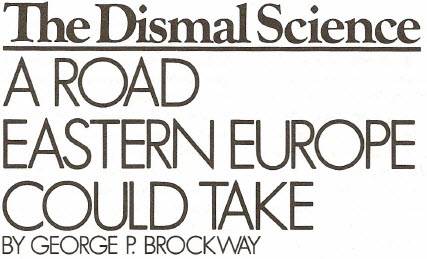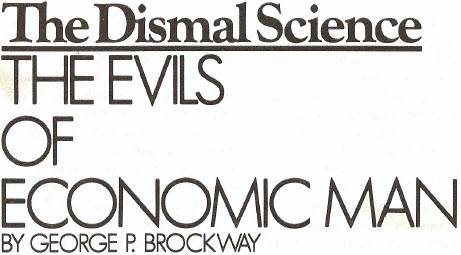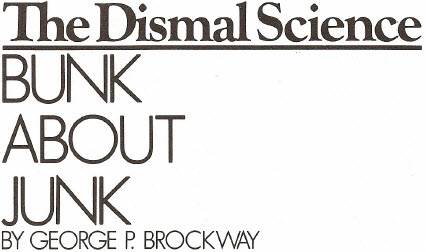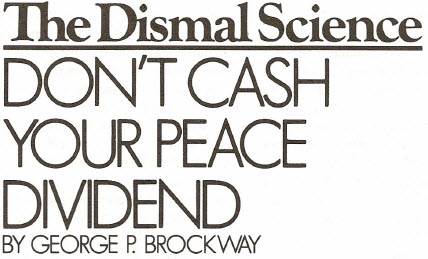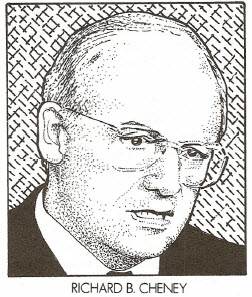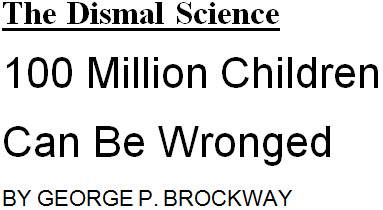By George P. Brockway, originally published November 12, 1990
THE COUNTRIES of Eastern Europe have a unique opportunity to combine the virtues of capitalism and socialism. If they do not seize the opportunity-and Poland, for one, seems to be kicking it away-they will be in danger of combining the vices of both systems.
Capitalism’s virtues are the freedom and responsibility that come with being your own master. Its vice is class conflict. Only a small minority has so far enjoyed the capitalist virtues to the fullest, while a different and much larger minority suffers poverty and unemployment and hopelessness.
Socialism’s virtues are the ideal of classlessness and the practical abolition of unemployment. Its vice is totalitarianism-and too often has prevailed.
No nation has yet succeeded in combining the virtues and avoiding the vices. Perhaps it cannot be done, at least not on a large scale, or not for very long. Yet there is no doubt that some societies are vastly better places to live in than others, and that vast changes for the better are achievable in every society. It is sad when the road not taken is a better road.
Something like the imprinting of goslings seems to be happening in the nations of Eastern Europe. The collapse of the Communist order has occurred at a time when the most visible examples of capitalism are limping badly. The fledgling democracies (or some of them) seem determined to copy as well as follow the limpers.
The United States, Great Britain and Germany have shockingly high unemployment rates, and Japan’s is growing. In all these countries, the gap between the rich and the poor has always been great and has recently been widening. In all these countries, high or rising interest rates are regarded with complacency.
In all these countries, the general will is so corrupt that the growth of unemployment actually is greeted with cheers and a rising stock market. In all these countries, a hyper volatile stock market is considered an indicator of prosperity.
Nevertheless, those traits of the world’s most successful capitalist countries are regarded with envy by many of the new governments in Eastern Europe. Unemployment (previously unknown) is embraced as a necessity for free enterprise. Higher prices are somehow thought necessary to combat inflation (no doubt on the same theory that recommends higher interest rates to us), and lower wages are decreed (although in the future they will presumably be set by the free market).
Forward-looking Hungary has been trying for several years to get a stock market going and is ashamed that an average day’s trading is still only 40,000 shares. How can arbitragers and brokers and takeover experts get along on such slim pickings? Poland hopes to do better and has dispatched a commission to see how we run our admirable exchanges.
Such misdirections are bad enough, yet it seems likely that worse is in store. The newly liberated countries are being set up to recapitulate the disasters of Africa and Latin America. The setting up turns on a confusion of thought and may be only stupid, not deliberate. The disasters, though, will be real enough.
The confusion is of capital and money. They are both necessary, but they are not the same. With capital you can make things. With money you can buy things, including capital. You cannot make things with money, nor can you buy things with capital, except on an insignificant scale. These distinctions, although elementary, apparently are easy to forget; otherwise the privatization of Eastern Europe would be a cinch.
As matters stand, enthusiasts for privatization want to consult investment bankers (if they’re not bankers themselves), print up a lot of stock certificates, hire a hall or a curbside for a stock market, plug in their computers, and let her rip. There are complications, however. Consider the Polish tractor industry.
The Poles make a pretty good tractor, but today they’re overflowing the factory yards. The factories used to be subsidized, and so were the farmers who bought them and the city folk who bought farm produce. Now none of them will be subsidized (this is the free market hope). A few city folk seem to have some money and are delighted to buy fresh produce off the tailgates of a few farmers’ trucks. The TV news programs report that a Harvard professor is pleased with this example of free enterprise. But it is pretty small potatoes and evidently does not build much of a demand for tractors.
So there’s this tractor industry with the ability to make a product it can’t sell. Who will buy the operation? You might take a flyer on it if you could pick it up for, say, a quarter of what it cost to build. It might eventually payout, especially if somehow the Polish economy recovered from its self-imposed austerity. Then you could float a stock issue, which might respond to the cries in the stock market hall and make you very rich indeed.
But we have not asked where you got the money to buy the business. Of course, you will have borrowed it. The new Bank for European Reconstruction and Development is being established for that very purpose-to underwrite privatization. Unfortunately the bank will have only about $12 billion to lend, and perhaps 30 or 40 times that will be needed. So commercial banks and investment banks around the world will be encouraged to participate, as they were encouraged to participate in the Great Recycling of OPEC’S winnings. The new financing will probably be structured more like a leveraged buyout, in that bonds will mostly be sold to “institutions” – pension plans, mutual funds, and so on. Needless to say, these junk bonds will be given a more high-sounding name.
High sounding or not, junk is junk, as we’re beginning to understand. A subsidized tractor factory that loses money is not likely to become profitable when the subsidy is withdrawn and is replaced by interest charges of 14 per cent or more. In short, the privatization of Eastern Europe bids fair to wind up in something like a combination of the recycling of OPEC’S profits and the junk-bonding of American business. The newly liberated countries will find themselves burdened by unmanageable debt, while our institutions are burdened by uncollectible loans. The citizens of Eastern Europe, who so bravely and joyfully threw off the chains of communism, will be cruelly deceived.
None of that is necessary. It will probably come about because the whole world seems to have confused finance with industry, or, as aforesaid, money with capital. Everyone assumes that what Poland and the rest need to do to become viable capitalist nations is sell their industry to entrepreneurs. What they actually need to do – and have the opportunity of doing – is transfer the ownership of capital, which is what they used to call “the means of production,“ to the workers, thus making them entrepreneurs[1].
Take that tractor factory. It is currently owned by the State – that is, by the people who work there and all the other people of Poland. The same is true of the farms that used to buy the tractors and the grocery stores that used to buy the farm produce and every other productive organization in the country. To privatize their industries, all the Poles have to do is transfer the ownership from the people collectively to the people who work in each separate business. No money has to change hands; the capital exists. The new Reconstruction and Development Bank’s money can be used to finance modernization of the infrastructure.
POLAND – and the rest of Eastern Europe – could become a land of producers’ cooperatives. It could combine the best features of capitalism and socialism (see “The Labor Theory of Right,” NL February 11-25, 1985, and “Faint Praise for Profit Sharing,” NL March 25, 1985). Its capitalists and laborers would not be at each other’s throats, because they’d be the same people. Its industries would not stagnate for lack of incentive. And all this could-can-be done at no cost.
Contrast the situation in Eastern Europe with that of our unions trying to buyout United Air Lines. First, the unions have to offer an outrageous price for the company’s stock to save it from investment bankers who want to break up the company. Second, they have to issue junk bonds at usurious interest to pay for the stock. Third, they have to hire an executive for $9 million, not because he knows anything about running an airline, but because he has the confidence of the junk bond bankers.
No doubt you can easily think up dozens of objections to the employee-ownership scheme; and if you’ll stay after class I’ll try to answer them. In the meantime, let me suggest that most of your objections will be similar to one raised recently by Barry Bosworth of the Brookings Institution. He points out that those who work for poorly run businesses would not get a fair shake, to which I reply that the bankers’ alternative would give them no shake at all.
Others may object that the Polish tractor business, say, is hampered by obsolete machinery and a swollen payroll. What is to be done? The classic bankers’ solution would be to abandon the whole thing and start over, with a leaner work force and a meaner mountain of debt. The money would come partly from the new bank and partly from Ford or Honda or Mercedes. The new plant would be able to compete internationally. That is, it would cut into the sale of American or Japanese or German tractors, and naturally into American or Japanese or German employment.
As for the Poles, many or most of the tractor workers would be out of a job that’s the principal reason for the new plant. Those remaining would find that their pay had to be held down so the plant could handle its debt service and still compete internationally. The debt service would of course go abroad, and so would the profits, if any. As in Africa and Latin America, there would be no winners from this creative destruction, with the possible exception of some foreign bankers.
If Eastern Europe copies the mistakes of its Western models, the best it can hope for is that the suffering imposed on the present generation will be followed by a better life for the next generation. This, you will recall, was the promise of communism, too. Such promises are rarely fulfilled. A more likely fate is that of Africa and Latin America (and of the creditor countries as well)-being doomed to decades of what is politely called austerity because of the Great Recycling.
The road less traveled by might still be taken. As Jake said to Lady Brett, isn’t it pretty to think so?
The New Leader
[1] Not a new thought to the author. 35 years earlier, while awaiting a return home after the end of WW II he wrote An Economic Bill of Rights
